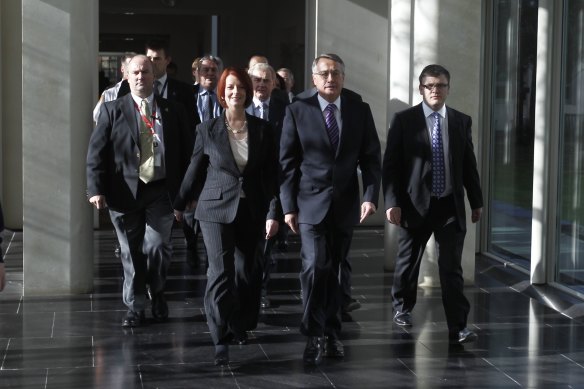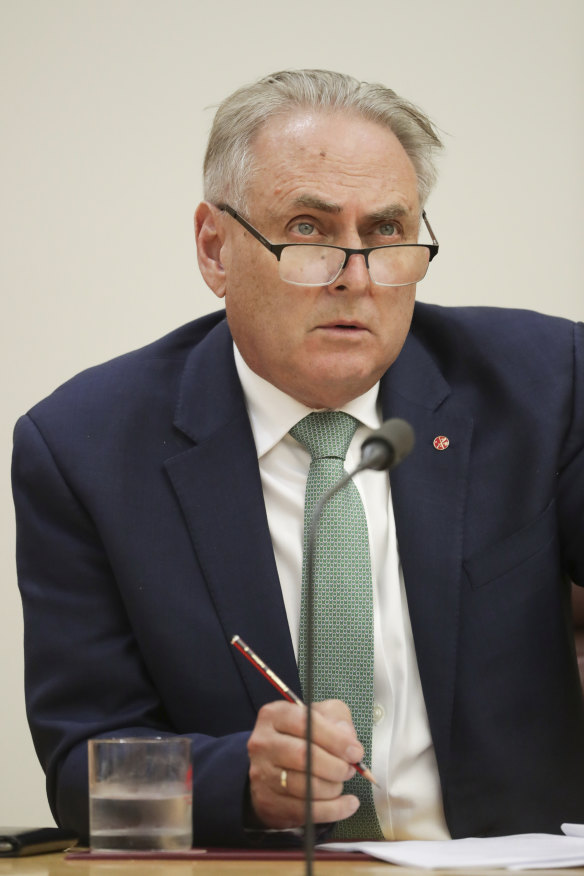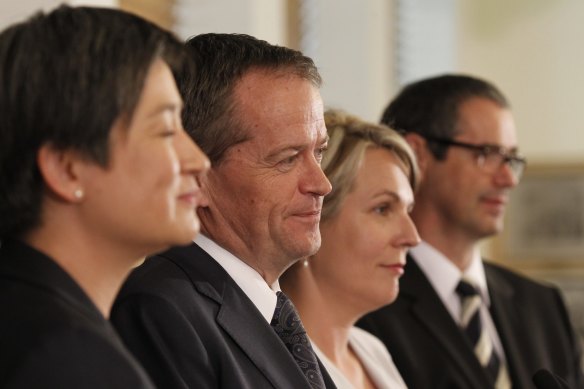Explainer
- Explainer
- Factional politics
What are Labor’s factions and who’s who in the Left and Right?
Political insiders talk about them, journalists speculate on them and they play a crucial role in who leads the Labor Party. But what is a faction, what do they do and why do they matter so much?
They’re derided as faceless men, they make and break Labor leaders and they determine the policy decisions the ALP takes.
Amid recent chatter about Anthony Albanese’s leadership, there has been speculation about whether he still has the backing of a particular faction or state group.
Factions play a crucial role in deciding the leader of the ALP (though the party membership now also gets a vote), in allocating frontbench portfolios, in choosing who gets to run for parliament, and in deciding the party’s policy positions. But if factional divisions run too deep and the party is divided, it’s that much harder for Labor to form government.
So where did these factions come from? What do they do and why do they matter? And just how powerful are they?

In 2010, Julia Gillard emerged victorious after a leadership ballot toppled prime minister Kevin Rudd, a move made possible by the Right. Her removal and Rudd’s re-instatement three years later was also made possible by a significant group in the Right deserting her.Credit: Andrew Meares
What’s a Labor faction?
Factions are as old as parliamentary democracy. While the Liberal Party has groupings of interests around policy positions or personalities – social conservatives and moderates, wets and dries and, in NSW for example, three groups (the Hard Right, the Centre Right and the Moderates) – historically they are nowhere near as highly structured or formalised as in the ALP.
There are two major factions in the ALP – the Right and the Left. Traditionally, the Left has been more progressive, focused on social issues and more supportive of intervening in the private sector, whereas the Right has been more economically dry, more supportive of the US alliance and in some cases, more socially conservative.
Though Labor people have leaned towards, or been grouped as, left or right for decades, the factional system in the party began to be formalised in the 1970s. By the time they’ve entered Parliament, MPs will have been in a faction for years, as rank-and-file members. Sometimes they will have been invited to join a faction at some point along the way, sometimes they might request to join a faction, but the actual process remains opaque.
While the majority of rank-and-file members are Left-leaning, once in Parliament, the Right usually has more MPs – though the number of Left MPs has grown in the past decade.
As Nick Dyrenfurth, a former Bill Shorten staffer and executive director of the Labor-aligned John Curtin Research Centre points out in an essay in The Write Stuff, every single federal Labor leader to have taken Labor from opposition into government – dating back to Andrew Fisher in 1910 – has been from the Right.
Julia Gillard (notionally from the Left, but close to the Right) and Albanese are the only two Labor leaders since 1967 to have come from the Left faction.
What do factions do and why do they matter?
In the Australian Labor Party, factions gather like-minded rank-and-file members and MPs into cohesive groups to advance policy positions – for example, to argue for more ambitious climate change policies or for a change in refugee policy.
In Canberra, factional conveners manage the egos and ambitions of MPs seeking entry to the ministry and help parcel out promotions on the basis of merit and quotas (see below).
Factions are also used to manage internal policy fights, from those over the privatisation of Qantas and the Commonwealth Bank in the 1980s and 1990s through to same-sex marriage and refugee policy in the 2000s.
They bring order and organisation to the caucus (which is the parliamentary Labor Party) and, as one senior Left figure puts it, the faction conveners are “the people who put the bomb vest on and represent the Left’s views in the caucus, and take the heat for the collective”.
Factions play a key role in choosing candidates for safe seats and newly created seats.The Left, for example, will run a more progressive candidate in the Greens-held seat of Melbourne, whereas the Right might get to stand a candidate in an outer-suburban seat in Sydney that Labor wants to win back from the Liberal Party. Factions also play a role in deciding the order of candidates on the Senate ballot at an election, where the difference between being first, second and third position can mean a place in Canberra or not.
As Dyrenfurth puts it: “Factions worked efficiently in the Hawke-Keating years and that’s why they won elections – they were coherent and organised and could deal with each other.”
Dyrenfurth warns about the growth in sub-factions of Labor factions (known as fractions) as being “a recipe for disaster”.
He warns about the Balkanisation, or growth in sub-factions of Labor factions (known as fractions) as being “a recipe for disaster” as it “invites the prospect of an extended period in the electoral wilderness federally. It’s bad in terms of a proper, vibrant contest of ideas, it’s bad for party stability and discipline, and it’s bad in terms of not getting the best possible MPs into parliament to win government and implement Labor policies”.
After retaking the leadership in 2013, Kevin Rudd brought in sweeping changes to democratise the ALP and reduce the power of factions, including giving members a 50 per cent say in the leadership vote and making it harder for the caucus to replace the leader.
That move came after Rudd’s removal in 2010, when the NSW Right (which considers itself the king-making faction) along with the Right in Victoria, SA and Queensland shifted to Julia Gillard and removed Rudd as prime minister.
Similarly, in 2013, it was a shift by enough people in these factions that helped get Rudd back into the top job. In theory, that can’t happen anymore because of Rudd’s changes – but that’s never been tested in practice.
What’s the current state of play in federal Labor?
At the moment, of the 94 Labor MPs in the House of Representatives and the Senate, 49 belong to the Right, 43 are in the Left and two are not factionally aligned.
The Left is currently allocated 14 of the 30 seats in the shadow ministry on a proportional basis and the Right receives 16, though they allocate those spots differently. The Left chooses its 14 frontbenchers from a national list of MPs, whereas the Right hands out frontbench spots using a state-based quota formula. The NSW Right gets six spots in the shadow cabinet, the Victorian Right gets four, the Queensland Right receives two places and WA, SA, Tasmania, the ACT and the NT are treated as one bloc – and take the final four frontbench spots.
The Left’s national conveners are Victorian MP Julian Hill, NSW Senator Tim Ayres and MP Sharon Claydon, while MP Matt Thistlethwaite is the national convener of the Right along with South Australian Senator Don Farrell.
Both factions have national meetings, usually on a Monday before parliament sits.
As one Right MP puts it: “The National Left tends to meet for about 90 minutes and the Right meets for about six minutes. The Left has much more formal procedures, whereas in the Right it’s more like, ‘Does anyone have any problems? OK, thanks’.”
Who are the powerbrokers in the Right?
While factional conveners play an important organisational role, the convener is not always the powerbroker (or faceless “man”) with the most influence.
While Thistlethwaite is the national convener of the Right – and his state faction – frontbench MPs Chris Bowen and Tony Burke are the most influential in that state. Joel Fitzgibbon, long the convener of the NSW and National Right, is now seen as on the outer for the “whatever it takes” faction.
In Queensland, Anthony Chisholm is the convener of the Right but Jim Chalmers as shadow treasurer is the most senior member of the group.
Perhaps the most influential national figure is South Australian Don Farrell (a veteran senator dubbed the Godfather) who has been the leader of MPs aligned with the Shoppies (the SDA or Shop, Distributive and Allied Employees’ Association union) grouping within the caucus for more than a decade.

SA Senator Don Farrell is called the Godfather. As one MP puts it: “If the Farrell group had to choose between their state or Don’s view they would almost certainly choose Don.”Credit: Alex Ellinghausen
Though Farrell’s power base is the six Right-aligned MPs in South Australia, he convenes the Right-aligned small states (WA, SA, Tasmania, the ACT and the NT) MPs and can count on them for influence.
And there’s an additional layer to Farrell’s influence – NSW Senator Deb O’Neill and Victorian senators Raff Ciccone and Daniel Mulino are members of their state factions but are also aligned with the socially conservative Shoppies union and, therefore, with Farrell.
As one MP puts it: “If the Farrell group had to choose between their state or Don’s view they would almost certainly choose Don.”
And then there is the Victorian Right, which is best described as two major sub-factions with a Shoppies overlay. For years, the Right has been run collectively by the ShortCons – named after Bill Shorten and former senator Stephen Conroy.
The sub-factions work well together in Canberra, most of the time, but are often at loggerheads at a state level. Conroy retains influence, but deputy Labor leader Richard Marles has joined the former senator as head of one of the two sub-factions (fractions) in Canberra. This group includes MPs Jo Ryan, Tim Watts, Rob Mitchell and, more loosely, Josh Burns. Anthony Byrne is close to both Marles and Shorten.

Power plays: In 2013, Bill Shorten (second from left) was Opposition leader, his deputy was Tanya Plibersek (third from left). Leader of the Opposition in the Senate was, and still is, Senator Penny Wong (left) and her deputy at the time was Senator Stephen Conroy.Credit: Andrew Meares
The Australian Workers Union-Shorten group of MPs includes Peter Khalil, Clare O’Neil and Kimberley Kitching. MP Mark Dreyfus, Senator Raff Ciccone and MP Daniel Mulino lean towards Shorten, too, but the latter two are also close to Farrell’s Shoppies group.
When alternative leaders to Albanese are speculated on, it’s Bowen, Chalmers, Burke and Marles most often mentioned as potential alternatives – but any such switch is unlikely as the current leader has support from much of the Right, still, and there is little appetite for bloodletting.
Who are the powerbrokers in the Left?
The Left is more nationalised and therefore more straightforward. While conveners Hill, Ayres and Claydon have some influence, Albanese as the leader (and a long-time powerbroker) sits at the top of the factional pile.
Tanya Plibersek is one of the most senior figures in the NSW Left, popular with rank-and-file members and touted in some quarters as a better option than Albanese for leader. But she’s less popular in the Left faction in the federal caucus – in a direct contest for Left votes, Albanese would win 37 or 38 of the 43 members of the Left.
South Australians Penny Wong and Mark Butler have considerable influence, too, as do Victorian MP Andrew Giles and NSW MP Pat Conroy, Tasmanian Senator Carol Brown (nicknamed the Godmother) and Queensland Senator Murray Watt.
A splinter group known as the Industrial Left, a rump of four MPs that was led by Senator Kim Carr (who has been at loggerheads with Albanese for years and who backed Shorten for leader in 2013 and 2016) has effectively ceased to exist as a parliamentary grouping – though it still has power and influence through its alliance with major unions, in the state Labor party and labour movement.
Aside from the Shoppies, other major unions aligned with the Right faction include the Transport Workers Union and the Australian Workers Union. On the left: the Australian Manufacturing Workers Union, the United Workers Union, the Community and Public Sector Union and the Construction, Forestry, Mining, Maritime and Energy Union (though the divisions in the CFMMEU could form another explainer).
So are the factions likely to want to change leaders any time soon?
While it’s true that some in the ALP caucus aren’t 100 per cent happy with Albanese, the leader can count on the rusted-on support of at least 37 or 38 members of the Left faction – and large sections of the Right, too, from NSW, Victoria and South Australia.
As a result, he’s unlikely to face a challenge any time soon from any of the other would-be leaders of the party.
That could change, of course, if Albanese were to make a disastrous mistake or three –and if that happened, it would be the factions, in the first instance, thrashing out who would replace him.
Read also: Who’s who in the Liberal Party’s factions
Let us explain
If you'd like some expert background on an issue or a news event, drop us a line at explainers@smh.com.au or explainers@theage.com.au. Read more explainers here.